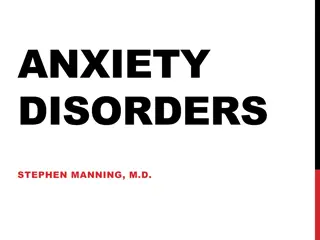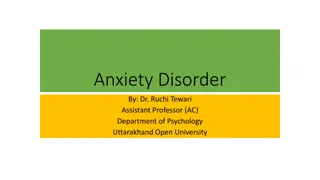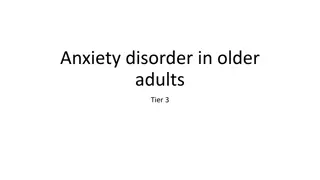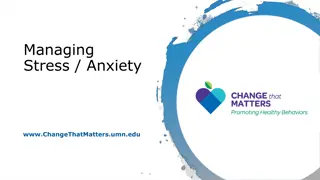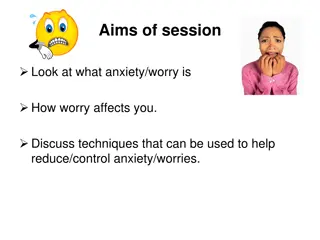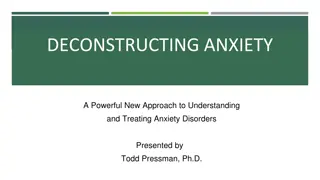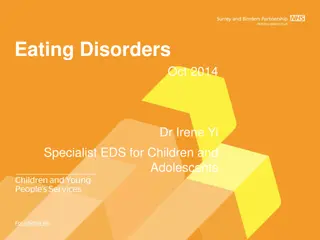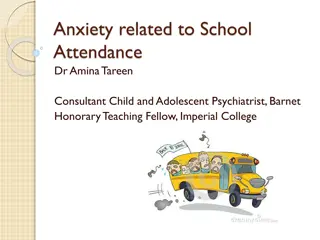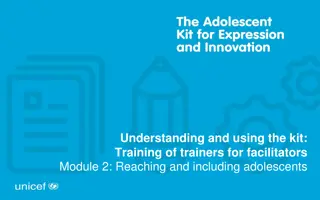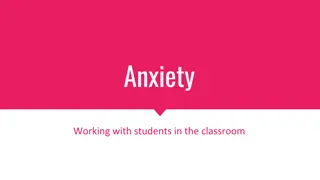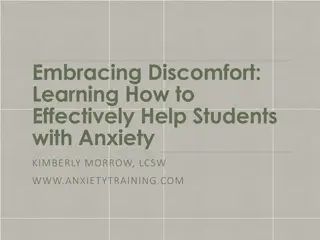Understanding Anxiety Disorders in Latina Adolescents
Latina adolescents in the United States are facing increasing challenges with anxiety disorders. Factors such as cultural identity, rapid population growth, and adverse childhood experiences contribute to the prevalence of anxiety disorders in this population. Recognizing the unique needs and experiences of Latina adolescents is crucial for providing effective support and intervention strategies.
Download Presentation

Please find below an Image/Link to download the presentation.
The content on the website is provided AS IS for your information and personal use only. It may not be sold, licensed, or shared on other websites without obtaining consent from the author. Download presentation by click this link. If you encounter any issues during the download, it is possible that the publisher has removed the file from their server.
E N D
Presentation Transcript
I DONT KNOW WHY I CAN T JUST CALM DOWN: Latina Adolescents Struggling with Anxiety Disorders Nancy Solberg
Majority of individuals from Latin American countries prefer to self-identify by their family s country of origin Gender-neutral, non-binary Emphasizes indigenous cultures and languages (Saldana-Portillo, 2017; DeGuzman, 2017; Image by Wes Bausmith)
Latinxsin the United States Fastest growing minority ethnic group in the U.S. 17% of U.S. population is Latinx By 2020, 1 in 5 adolescents will be Latinx By 2030, the Latinx adolescent population will have a 60% increase While the population will continue to grow nationwide, recent growth spikes in non-historically immigrant-receiving urban and rural communities mean communities in the Southeast are facing larger numbers for the first time (Coleman-Minahan, 2016; Potochnicket al., 2012; Benuto, 2017)
Projected Latinx population of North Carolina in 2035: 1.6 million 59% of North Carolina s Latinx are U.S.-born 77% of North Carolina s Latinx speak a language other than English at home Most common countries of origin for North Carolinian Latinx: Mexico (57%), Puerto Rico (10%), El Salvador (6%), Honduras (5%), Guatemala (3%) Durham County s Latinx population in 2017: approximately 41,000 = 30% 7,000 Latinx individuals between ages of 10 and 19 (U.S. Census Bureau, 2017; Image from Latinos in/en Durham)
Adverse Childhood Experiences (ACEs) Can include parental domestic violence, substance abuse, mental illness, child abuse and/or neglect, criminal justice involvement, poverty, homelessness, and parental death. Children exposed to ACEs are more likely to experience physical, mental, social, and behavioral problems as adults than those not exposed to ACEs 78% of Latino children have suffered at least 1 ACE 28% of Latino children have suffered 4 or more ACEs (Felitti et al., 1998; Ramirez, 2017)
Anxiety Disorders Among Children & Adolescents Almost 25% of adolescents meet diagnostic criteria for an anxiety disorder Earliest mean age of onset (6 years old) Younger children more likely to suffer from specific phobias and separation anxiety Adolescents more likely to suffer from panic disorder, agoraphobia, social anxiety, and generalized anxiety disorder Anxiety disorders place children at greater risk for developing depression and substance abuse disorder (Merikangas et al., 2010; Knapp et al., 2015; William T. Grant Foundation, 2015)
Anxiety disorders are far more common for female adolescents than male adolescents (Creswell & Waite, 2016)
This should be of special concern since Latina adolescents are already the adolescent group with the highest rate of suicide attempts As of 2015, 15% of Latina adolescents in the U.S. have attempted suicide and 26% of Latina adolescents in the U.S. have considered suicide (Nepon et al., 2010; Merikangas et al., 2010; Perez-Rodriguez et al., 2014)
Barriers to Accessing Mental Health Care Lack of insurance or adequate insurance Lack of awareness about mental health problems and services available Lack of culturally competent mental health professionals Cultural stigma associated with mental illness Language and shortage of bilingual mental health professionals Problems identifying psychiatric symptoms when chief complaint is somatic Documentation Geographical access and transportation
Recommendations Screen for anxiety using culturally and linguistically appropriate tools Learn that anxiety can reported to health care providers in different ways depending on the culture of the individual Example: Many Latinas complain of somatic symptoms, feelings of tiredness, worrying too much, and use idioms of distress like ataque de nervios and susto Work from a mindset of cultural humility and curiosity Know where to find services in Spanish don t expect families to be able to find those services themselves Be aware of the unique barriers this population commonly faces and how you can help them overcome those barriers Advocate for more bilingual services and more bilingual professionals (Arredondo et al., 2014)
References Arredondo, P., Gallardo-Cooper, M., Delgado-Romero, E. A., & Zapata, A. L. (2014). Culturally responsive counseling with Latinas/os. American Counseling Association. Retrieved from https://ebookcentral-proquest-com.libproxy.lib.unc.edu/lib/unc/detail.action?docID=1889225 Benuto, L. T. (Ed.).(2017). Toolkit for Counseling Spanish-Speaking Clients. Springer International Publishing. doi: 10.1007/978-3-319-64880-4 Coleman-Minahan, K. (2016). The socio-political context of migration and reproductive health disparities: The case of early sexual initiation among Mexican-origin immigrant young women. Social Science & Medicine, 180, 85-93. doi: 10.1016/j.socscimed.2017.03.011 Creswell, C. & Waite, P. (2016). Recent developments in the treatment of anxiety disorders in children and adolescents. Evidence-Based Mental Health, 19(3), 65-69. doi: 10.1136/eb-2016- 102353 DeGuzman, M. (2017). Latinx: Estamos aqui, or being Latinx at UNC-Chapel Hill. Cultural Dynamics, 29(3), 214-230. doi: 10.1177/0921374017727852 Felitti, V. J., Anda, R. F., Nordenberg, D., Williamson, D. F., Spitz, A. M., Edwards, V., Koss, M. P., & Marks, J. S. (1998). Relationship of childhood abuse and household dysfunction to many of the leading causes of death in adults: The adverse childhood experiences (ACE) study. American Journal of Preventive Medicine, 14(4), 245-257. Knapp, A. A., Blumenthal, H., Mischel, E. R., Badour, C. L., & Leen-Feldner, E. W. (2015). Anxiety sensitivity and its factors in relation to generalized anxiety disorder among adolescents. Journal of Abnormal Child Psychology, 44, 233-244. doi: 10.1007/s10802-015-9991-0 Merikangas, K. R., He, J. P., Burstein, M., Swanson, S. A., Avenevoli, S., Cui, L., Benjet, C., Georgiades, K., & Swendsen, J. (2010). Lifetime prevalence of mental disorders in U.S. adolescents: Results from the National Comorbidity Survey Replication Adolescent Supplement (NCS-A). Journal of the American Academy of Child and Adolescent Psychiatry, 49(10), 980-989. doi: 10.1016/j.jaac.2010.05.017 Nepon, J., Belike, S. L., Bolton, J., & Sareen, J. (2010). The relationship between anxiety disorders and suicide attempts: Findings from the national epidemiologic survey on alcohol and related conditions. Depression & Anxiety, 27(9), 791-798. doi: 10.1002/da.20674 Perez-Rodriguez, M M., Baca-Garcia, E., Oquendo, M. A., Wang, S., Wall, M. M., Liu, S. M., & Blanco, C. (2014). Relationship between acculturation, discrimination, and suicidal ideation and attempts among US Hispanics in the national epidemiological survey of alcohol and related conditions. Journal of Clinical Psychiatry, 75(4), 399-407. doi: 10.4088/JCP.13m08548 Potochnick, S., Perreira, K. M., & Fuligni, A. (2012). Fitting in: The roles of social acceptance and discrimination in shaping the daily psychological well-being of Latino youth. Social Science Quarterly, 93, 173-190. doi: 10.1111/j.1540-6237.2011.00830.x Ramirez, A. (2017). Latino childhood development research: Childhood trauma. Salud America! Retrieved from: https://salud-america.org Saldana-Portillo, M. J. (2017). Critical Latinx indigeneities: A paradigm drift. Latino Studies, 15(2), 138-155. doi: 10.1057/s41276-017-0059-x U.S. Census Bureau (2017). Hispanic origin. Retrieved from https://www.census.gov/topics/population/hispanic-origin/about.html William T. Grant Foundation. (2015). Disparities in child and adolescent mental health and mental health services in the U.S. Washington, DC: Alegria, M. & Green, J. G.
This project was supported by the Health Resources and Services Administration (HRSA) of the U.S. Department of Health and Human Services (HHS) under M01HP31370, UNC-PrimeCare, $1,920,000.00, 100% financed with governmental sources. This information or content and conclusions are those of the author and should not be construed as the official position or policy of, nor should any endorsements be inferred by HRSA, HHS or the U.S. Government.




